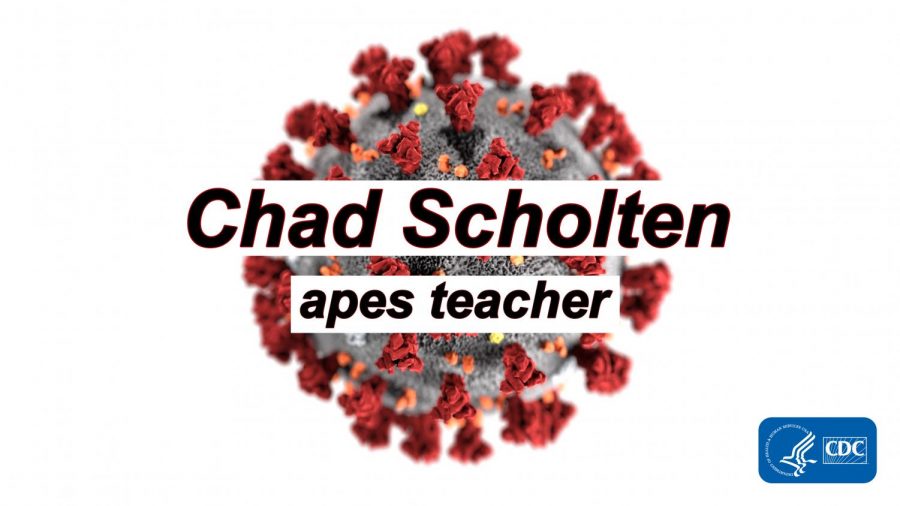Chad Scholten
Name: Chad Scholten
Role: AP Environmental Science and Human Anatomy/Physiology teacher
1. What unexpected challenges have arisen in the switch to online teaching?
“One unexpected challenge is dealing with asynchronous instruction; this means instructing students when everyone has a different schedule and not expecting all 30 students in a class to be available during a specific 60-minute window of time. Interacting with students through Zoom video conferencing has also been challenging because it’s not as personal. Sure, you can see their faces and hear them, but it’s very teacher-directed, and there is very little student to student collaboration and discussion. I am not able to have a lesson where students can work in a group of two or four and then come back as a whole class and give teacher feedback. So, lessons change, and teaching procedures are also changing.”
2. As a science teacher, are you still trying to have your students complete labs at home? What does that look like for you?
“The challenge with students doing labs at home is everyone has a different environment and supplies to use for investigations. Even when we were in class at [school], some of the investigations were inquiry-based, and that means each student designed a different investigation, so, in that regard, doing an investigation at home is similar in the design. To carry out an investigation is very different between students. An example of this is [when] I assigned my environmental class an investigation around the topic of water quality. Some students could walk out the back door to the Thornapple River, and other students were a 15-minute drive from a water source.”
3. Have you seen students rise up to face these challenges in ways that have been surprising, or maybe not so surprising, to you?
“This is another challenge teachers face with remote learning, and that is how to motivate students who need face-to-face interaction to keep them completing their learning. Yes, there are students who are not doing anything during this time at home, and there are other students who are doing every assignment the teacher asks them to complete.”
4. How have quarantine and COVID-19 affected your life outside of school?
“My schedule at home allows me to have more flexibility. The school setting is very structured and regimented. For every hour, you have students coming, and teachers and students have to schedule times when they use the bathroom or when they eat. So, the benefit of at-home learning is my flexibility to teach, grade, develop lessons, spend time with my family, and spend time outdoors.”
5. Do you have a favorite story from quarantine so far?
“Teachers have the opportunity to observe human behavior on a daily basis, and some of the more amusing behaviors of humans are during times when there [are] uncertainty and stress. This can be seen in the classroom when students are under stress or if their schedule is changed, so the amusing aspect is that it happens to adults as much as students. In a grocery store, one person may be buying their normal weekly grocery items, or another person has their cart filled with paper products and water bottles, [or] another cart is filled with macaroni and cheese and pasta, and another cart is completely filled with an assortment of adult beverages. So during this time, what is important and valued by people becomes obvious.”
6. What are your personal predictions for the 2020-21 school year?
“I have been listening and reading about predictions from experts, mostly those in the epidemiology field, and no one knows an answer, but what is almost certain is that it will not look like last year’s fall start to the school year. We may all be wearing masks over our nose and mouth, we may have 15 students per classroom during a given period, we may not assemble for lunch, we may have students on a every other day schedule coming to school to limit interactions. We may not have fans in the stands for football games or volleyball matches. One of the reasons that no one knows is because we have to make predictions about human behavior, and that is a large variable in the production model. If people continue to practice social distancing, wearing masks throughout the summer, and washing their hands, then the fall may look closer to our normal school year. My prediction is that people will relax and not practice social distancing and wearing masks unless they are told to do so, and when we all get back to school and colleges return to session, we may see an increase in the number of cases of COVID-19.”
7. Have you begun making any plans for teaching next year?
“This spring, I took and completed two graduate classes that deal with how to teach online classes from a distance [and] how to create and use videos in lessons. This type of teaching has been used in the past and is referred to as a flipped classroom, where students watch videos at home and then come to school and discuss and maybe work on assignments in front of the teacher. I can see this type of style for myself where the time at school at Central will be a time to work through problems and provide an environment for students to work in groups and discuss.”
8. In what ways, if any, are you staying in contact with your co-workers?
“Once a week, the science department will meet through Zoom video conferencing.”
